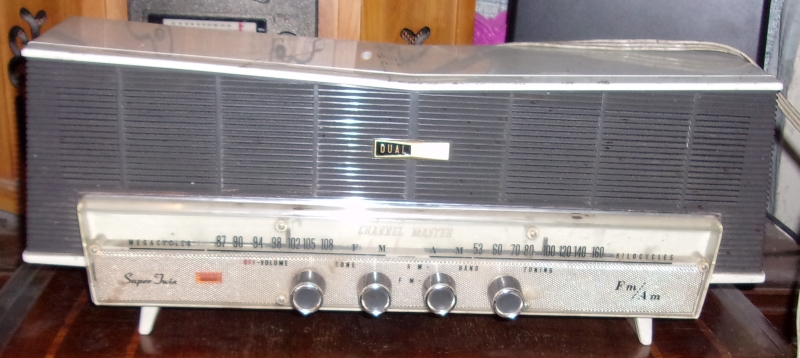05-19-2022, 05:13 PM
I already posted this radio in the finds topic, but here is where I will tell the story of resurrecting it from the dead and ask for a little help for the future.

I had really been looking for the Channel Master Super Fringe model, but recalled this radio had been sitting in the backroom of my buddy's appliance shop since forever. One of those flea market buys he had made and it just hummed and would barely pull in anything, so it got stuck on a shelf until early this afternoon when I fished it out and began checking tubes and trying to clean controls. All the tubes were original and all were bad except for the 12AV6 at least at first. The hum was from a dirty volume control that I had to hold the radio at odd angles to get to. Also the control is loose, but I cannot get the chassis out. (More on that soon.) Anyways, it did come back to life, but was not happy on AM and was a bit muddy sounding so I swapped out the 12AV6 which had started coming up as questionable on his checker. AM came back to life and the radio sounded much better. Upon getting it home, it was still touchy with a buzz in the left speaker, so I pulled the 50C5 I had swapped for the weak 35C5 and put in my last new 35C5. Even happier radio though it does NOT like my one local station on FM. (Big surprise there, few of my vintage radios do.) The more it is played on the smaller station, the better the radio sounds and it is not your typical dual speaker setup. The left speaker is a larger oval speaker with a much smaller one on the right and there IS a crossover cap, so a basic hi-fi setup. Seven tubes pick up rather well and it sounds good as long as the station isn't getting overboard on the bass.
Now for a question for help. How do you get this radio apart?! I thought I had enough speaker lead to tighten and clean the controls, but the two dial pointers run on a separate metal track that mounts to the cabinet. How the heck do you get this separate piece loose without fouling up the dial cord? Someday I will need to get in there.
By the way, it appears this radio was made by Sanyo for Channel Master.
I had really been looking for the Channel Master Super Fringe model, but recalled this radio had been sitting in the backroom of my buddy's appliance shop since forever. One of those flea market buys he had made and it just hummed and would barely pull in anything, so it got stuck on a shelf until early this afternoon when I fished it out and began checking tubes and trying to clean controls. All the tubes were original and all were bad except for the 12AV6 at least at first. The hum was from a dirty volume control that I had to hold the radio at odd angles to get to. Also the control is loose, but I cannot get the chassis out. (More on that soon.) Anyways, it did come back to life, but was not happy on AM and was a bit muddy sounding so I swapped out the 12AV6 which had started coming up as questionable on his checker. AM came back to life and the radio sounded much better. Upon getting it home, it was still touchy with a buzz in the left speaker, so I pulled the 50C5 I had swapped for the weak 35C5 and put in my last new 35C5. Even happier radio though it does NOT like my one local station on FM. (Big surprise there, few of my vintage radios do.) The more it is played on the smaller station, the better the radio sounds and it is not your typical dual speaker setup. The left speaker is a larger oval speaker with a much smaller one on the right and there IS a crossover cap, so a basic hi-fi setup. Seven tubes pick up rather well and it sounds good as long as the station isn't getting overboard on the bass.
Now for a question for help. How do you get this radio apart?! I thought I had enough speaker lead to tighten and clean the controls, but the two dial pointers run on a separate metal track that mounts to the cabinet. How the heck do you get this separate piece loose without fouling up the dial cord? Someday I will need to get in there.
By the way, it appears this radio was made by Sanyo for Channel Master.
No matter where you go, there you are.



